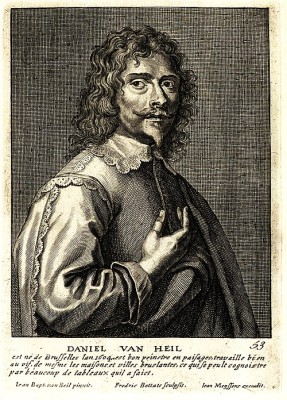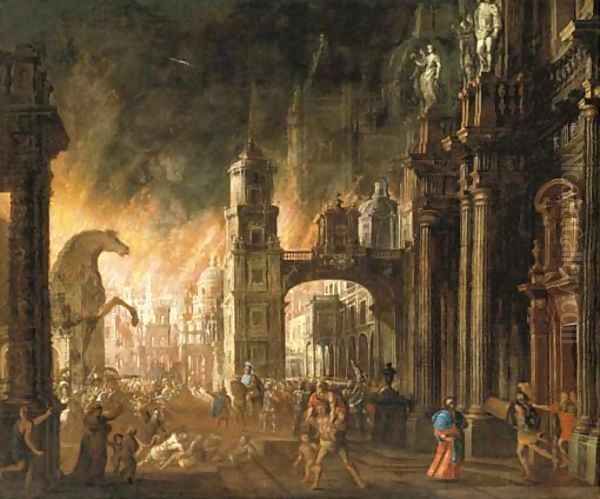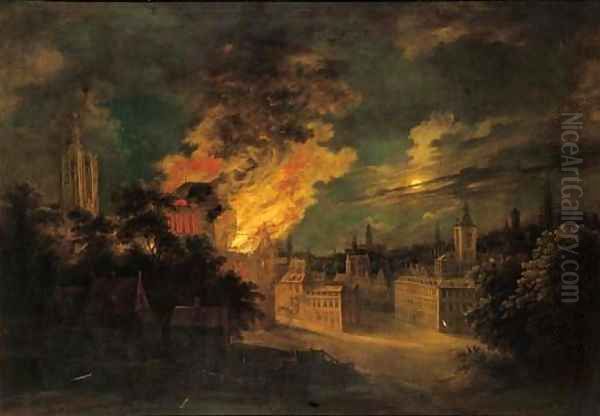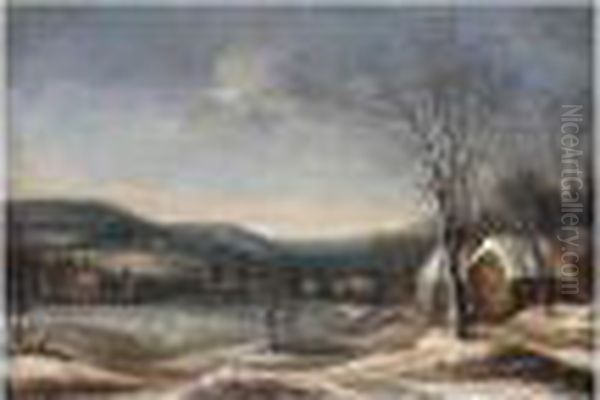
Daniel van Heil stands as a distinctive figure within the rich tapestry of 17th-century Flemish Baroque painting. Born in Brussels in 1604, he carved a unique niche for himself, becoming particularly renowned for his dramatic depictions of cities ablaze and his atmospheric winter landscapes. While biographical details remain somewhat scarce compared to contemporaries like Peter Paul Rubens or Anthony van Dyck, his surviving works offer compelling insights into his technical skill, thematic preoccupations, and his place within the artistic milieu of the Southern Netherlands. He hailed from a family deeply involved in the arts, a factor that undoubtedly shaped his career path.
Van Heil's artistic journey unfolded during a period of significant political and religious turmoil, but also one of immense artistic flourishing in Flanders. His lifespan (1604-1662) places him firmly within the Golden Age of Flemish painting, albeit slightly later than the towering figures of Rubens and Jan Brueghel the Elder. He specialized in genres that allowed for dramatic visual storytelling and the meticulous rendering of environments, setting him apart from the large-scale history paintings or courtly portraits favoured by some of his peers.
An Artistic Family in Brussels
Daniel van Heil was born into an environment steeped in artistic practice. His father, Leo van Heil the Elder (c. 1570-1640s), was a painter, suggesting that Daniel likely received his initial training within the family workshop. This familial connection to the arts was profound; Daniel had two brothers who also became recognized painters. Jan Baptist van Heil (1609–after 1662) specialized primarily in history painting and portraiture, while Leo van Heil the Younger (1605–c. 1664) focused on architectural subjects, sometimes collaborating with other artists by adding architectural backgrounds.

This familial context is crucial for understanding Daniel's development. While specific records detailing his apprenticeship under a particular master outside the family are lacking, the influence of his father and the shared artistic environment with his brothers would have been formative. In 1627, Daniel van Heil achieved a significant professional milestone by becoming a master in the Brussels Guild of Saint Luke, the official organization for painters and other artisans in the city. Membership signified his formal recognition as an independent and qualified artist.
The Brussels Guild, like its counterparts in Antwerp and other major European cities, played a vital role in regulating the art trade, ensuring quality standards, and providing a framework for training apprentices. Van Heil's acceptance into the Guild indicates he had successfully completed his training and demonstrated the requisite skills to practice his craft professionally within the city. His career subsequently unfolded primarily in Brussels, the city of his birth and artistic formation.
The Painter of Fire: Cities in Flames
Daniel van Heil's most distinctive and perhaps most famous contribution to Flemish art lies in his dramatic and detailed paintings of conflagrations – cities engulfed in fire. This theme, while not entirely unique, was pursued by van Heil with a particular intensity and skill that became his hallmark. He depicted historical events, mythological narratives, and sometimes imaginary scenes of urban destruction, all rendered with a keen eye for architectural detail and the chaotic, terrifying beauty of fire.
His depictions often feature recognizable cityscapes or classical settings being consumed by roaring flames under night skies. The contrast between the dark, silhouetted buildings and the bright, flickering oranges, reds, and yellows of the fire creates intense visual drama. Van Heil masterfully captured the billowing smoke, the sparks flying into the air, and the desperate actions of tiny figures fleeing the disaster or attempting to combat the flames. This attention to both the large-scale spectacle and the small human details adds depth and pathos to his work.
These fire scenes were not merely exercises in dramatic effect. They often referenced specific historical events, such as the numerous sieges and sacks that punctuated the turbulent history of the Low Countries, or classical stories like the fall of Troy. By depicting these events, van Heil tapped into contemporary anxieties about war, destruction, and the fragility of urban civilization, while also showcasing his technical virtuosity in handling complex compositions and challenging light effects. His approach echoes, in some ways, the earlier fantastical depictions of hellfire by Hieronymus Bosch, but grounded in a more realistic representation of architecture and atmosphere.
Masterpieces of Destruction

Several key works exemplify Daniel van Heil's mastery of the conflagration scene. He painted multiple versions of The Sack of Troy, a popular theme drawn from classical mythology that allowed for the depiction of ancient architecture ablaze and dramatic human struggle. These paintings showcase his ability to blend historical imagination with his characteristic fiery spectacle, creating scenes of epic chaos and ruin. The Trojan Horse often features prominently, amidst collapsing temples and fleeing figures illuminated by the inferno.
Another significant work depicts a specific historical event: Antwerp Town Hall on Fire during the Spanish Fury of 4 November 1576. This painting captures the horrific sack of Antwerp by mutinous Spanish troops during the Eighty Years' War. Van Heil, painting decades after the event, reconstructs the scene with dramatic intensity, focusing on the iconic Antwerp Stadhuis (City Hall) engulfed in flames. The work serves as a powerful historical record and a testament to the trauma inflicted upon the cities of the Low Countries during this period. It highlights his skill in rendering specific, recognizable architecture under duress.
He also painted scenes like Fire at Brussels and Imaginary Fire at Antwerp (sometimes identified as the Explosion of the Antwerp Powder Magazine). Whether depicting actual events, imagined disasters, or historical/mythological narratives, these works consistently demonstrate his fascination with the destructive power of fire and his ability to translate it into compelling visual art. His contemporaries who explored night scenes or fires, like the Dutch painter Aert van der Neer or Egbert van der Poel (famous for depicting the Delft Thunderclap explosion), approached similar subjects, but van Heil's focus on the architectural setting and the sheer scale of urban disaster remained distinctive within the Flemish context.
Winter Landscapes: Capturing the Flemish Chill
Beyond the drama of his fire scenes, Daniel van Heil was also an accomplished painter of winter landscapes. This genre had a long and distinguished tradition in Flemish art, reaching back to pioneers like Pieter Bruegel the Elder, whose winter scenes profoundly influenced subsequent generations. Van Heil continued this tradition, creating atmospheric depictions of the Low Countries under snow and ice.
His winter landscapes often feature frozen rivers or canals bustling with activity. Tiny figures skate, socialize, or go about their daily chores against a backdrop of snow-covered buildings and bare trees. Van Heil excelled at capturing the specific quality of light in winter – often cool, sometimes crisp, occasionally softened by falling snow or mist. The muted colour palettes, dominated by whites, greys, blues, and browns, effectively convey the chill and stillness of the season.

Works like his Winter Landscape with Skaters, examples of which can be found in collections such as the Hermitage Museum in St. Petersburg and the Royal Museums of Fine Arts of Belgium in Brussels, showcase his skill in this genre. While perhaps less overtly dramatic than his fire scenes, these paintings demonstrate his versatility and his sensitivity to atmosphere and the nuances of the natural world. They connect him to a lineage of Flemish landscape specialists including Joos de Momper and Jan Wildens, who also excelled in capturing the diverse moods of the seasons.
Style and Technique: Detail and Drama
Daniel van Heil's artistic style is characterized by a combination of meticulous detail and dramatic effect. In both his fire scenes and winter landscapes, he paid close attention to architectural accuracy and the rendering of textures – be it the stone of burning buildings or the ice of a frozen canal. His compositions are often carefully constructed, leading the viewer's eye through the scene, whether it's a chaotic inferno or a peaceful winter panorama.
His handling of light is particularly noteworthy. In the conflagrations, the fire itself becomes the primary light source, casting dramatic shadows and illuminating the surrounding chaos with an intense, flickering glow. In his winter scenes, he masterfully renders the subtle, diffused light of an overcast sky or the sharper light of a clear, cold day, capturing reflections on ice and the texture of snow. This sensitivity to light and atmosphere aligns him with broader trends in Baroque landscape painting across Europe.
While working within established genres, van Heil developed a recognizable personal style. His figures, though often small in scale relative to the landscape or architecture, are rendered with sufficient detail to convey action and emotion. His brushwork could be precise in architectural details, yet also fluid and energetic in depicting flames or atmospheric effects. He achieved a considerable reputation during his lifetime, praised for his inventive compositions and his technical prowess, particularly in his specialized themes.
Context: Flemish Baroque and Beyond
Daniel van Heil worked during the height of the Flemish Baroque, an era dominated by the artistic legacy of Peter Paul Rubens (1577-1640) and the elegant portraiture of Anthony van Dyck (1599-1641). While van Heil did not operate on the same grand scale or enjoy the same level of international fame as these giants, he occupied an important place within the diverse artistic landscape of the Southern Netherlands. His specialization in landscapes, cityscapes, and particularly his dramatic fire scenes, catered to a specific market demand and showcased a different facet of Flemish artistic production.
His work can be seen in relation to other landscape and cityscape specialists of the time. The tradition of detailed city views and landscapes established by artists like Paul Bril (who worked primarily in Rome but influenced Flemish art) and Jan Brueghel the Elder (known for his detailed landscapes and allegorical scenes) provided a foundation. Van Heil built upon this, infusing his scenes with a heightened sense of drama, particularly in his conflagrations.
His architectural interests connect him not only to his brother Leo van Heil the Younger but also to the broader tradition of architectural painting, exemplified by figures like Hendrick van Steenwijck the Elder and Younger, and Pieter Neefs the Elder and Younger, who specialized in meticulous church interiors. While van Heil's focus was often on exteriors, particularly under dramatic circumstances, the shared emphasis on accurate architectural rendering is evident. His winter scenes, as noted, follow in the footsteps of Pieter Bruegel the Elder and connect with the work of contemporaries like David Teniers the Younger, who also depicted peasant life and landscapes, sometimes including winter activities.
Comparisons can also be drawn with artists outside Flanders. The German painter Adam Elsheimer, though dying early (1610), was highly influential with his small-scale, intensely atmospheric night scenes, often lit by fire or moonlight, which had a wide impact. In the Dutch Republic, artists like Aert van der Neer specialized in moonlit and winter landscapes, sometimes including fires, while Egbert van der Poel became known for his depictions of the 1654 Delft powder magazine explosion, a theme resonant with van Heil's interest in urban disasters.
Legacy and Collections
Daniel van Heil passed away in Brussels in 1662, leaving behind a body of work that secured his reputation as a skilled and distinctive Flemish painter. While perhaps overshadowed in general art history surveys by the leading figures of the Antwerp school, his specialized focus on conflagrations and his accomplished winter landscapes earned him recognition and appreciation. His ability to combine detailed realism with dramatic, almost theatrical, effects appealed to collectors of his time and continues to attract interest.
His paintings found their way into significant collections across Europe. Today, works by Daniel van Heil are held in major museums, including the Royal Museums of Fine Arts of Belgium in Brussels, the Hermitage Museum in St. Petersburg, the Louvre in Paris, the Rijksmuseum in Amsterdam, and various other public and private collections. The presence of his works in these prestigious institutions attests to his historical importance and enduring artistic appeal.
His depictions of specific historical events, like the Spanish Fury in Antwerp, also serve as valuable visual documents, offering insight into how these traumatic moments were remembered and represented. His fire scenes, in particular, remain powerful examples of Baroque drama translated into the landscape and cityscape genre.
Conclusion: A Specialist's Vision
Daniel van Heil represents the depth and diversity of Flemish Baroque art beyond the towering figures of Rubens and van Dyck. He was a master specialist, channelling his considerable technical skill into depicting the extremes of urban experience – the destructive fury of fire and the quiet chill of winter. Born into an artistic family and trained within the Brussels tradition, he developed a distinctive voice, particularly renowned for his dramatic and meticulously detailed conflagrations.
His works capture the specificities of time and place – the architecture of Flemish cities, the activities of their inhabitants in different seasons, and the historical traumas they endured. Through his dramatic use of light, careful composition, and attention to detail, van Heil created compelling images that continue to engage viewers. He remains an important figure for understanding the breadth of genre painting in the 17th-century Southern Netherlands, a skilled practitioner whose fiery visions and frozen landscapes offer a unique window onto the world of the Flemish Baroque. His legacy is preserved in the museums that house his works, testament to a career dedicated to capturing both the spectacle of disaster and the quiet beauty of the winter world.